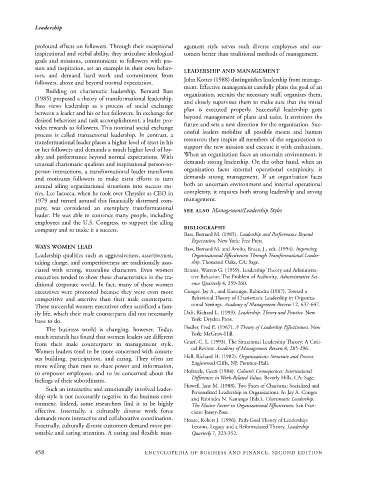Page 481 - Encyclopedia of Business and Finance
P. 481
eobf_L 7/5/06 3:14 PM Page 458
Leadership
profound effects on followers. Through their exceptional agement style serves such diverse employees and cus-
inspirational and verbal ability, they articulate ideological tomers better than traditional methods of management.
goals and missions, communicate to followers with pas-
sion and inspiration, set an example in their own behav-
LEADERSHIP AND MANAGEMENT
iors, and demand hard work and commitment from
followers, above and beyond normal expectation. John Kotter (1988) distinguishes leadership from manage-
ment. Effective management carefully plans the goal of an
Building on charismatic leadership, Bernard Bass
(1985) proposed a theory of transformational leadership. organization, recruits the necessary staff, organizes them,
and closely supervises them to make sure that the initial
Bass views leadership as a process of social exchange plan is executed properly. Successful leadership goes
between a leader and his or her followers. In exchange for
desired behaviors and task accomplishment, a leader pro- beyond management of plans and tasks. It envisions the
vides rewards to followers. This nominal social exchange future and sets a new direction for the organization. Suc-
process is called transactional leadership. In contrast, a cessful leaders mobilize all possible means and human
transformational leader places a higher level of trust in his resources; they inspire all members of the organization to
support the new mission and execute it with enthusiasm.
or her followers and demands a much higher level of loy-
alty and performance beyond normal expectations. With When an organization faces an uncertain environment, it
demands strong leadership. On the other hand, when an
unusual charismatic qualities and inspirational person-to-
organization faces internal operational complexity, it
person interactions, a transformational leader transforms
and motivates followers to make extra efforts to turn demands strong management. If an organization faces
around ailing organizational situations into success sto- both an uncertain environment and internal operational
ries. Lee Iacocca, when he took over Chrysler as CEO in complexity, it requires both strong leadership and strong
1979 and turned around this financially distressed com- management.
pany, was considered an exemplary transformational
SEE ALSO Management/Leadership Styles
leader. He was able to convince many people, including
employees and the U.S. Congress, to support the ailing
company and to make it a success. BIBLIOGRAPHY
Bass, Bernard M. (1985). Leadership and Performance Beyond
Expectation. New York: Free Press.
WAYS WOMEN LEAD Bass, Bernard M. and Avolio, Bruce, J., eds. (1994). Improving
Leadership qualities such as aggressiveness, assertiveness, Organizational Effectiveness Through Transformational Leader-
taking charge, and competitiveness are traditionally asso- ship. Thousand Oaks, CA: Sage.
ciated with strong, masculine characters. Even women Bennis, Warren G. (1959). Leadership Theory and Administra-
executives tended to show these characteristics in the tra- tive Behavior: The Problem of Authority. Administrative Sci-
ditional corporate world. In fact, many of these women ence Quarterly 4, 259-260.
executives were promoted because they were even more Conger, Jay A., and Kanungo, Rabindra (1987). Toward a
competitive and assertive than their male counterparts. Behavioral Theory of Charismatic Leadership in Organiza-
These successful women executives often sacrificed a fam- tional Settings. Academy of Management Review 12, 637-647.
ily life, which their male counterparts did not necessarily Daft, Richard L. (1999). Leadership: Theory and Practice. New
have to do. York: Dryden Press.
The business world is changing, however. Today, Fiedler, Fred E. (1967). A Theory of Leadership Effectiveness. New
much research has found that women leaders are different York: McGraw-Hill.
from their male counterparts in management style. Graef, C. L. (1993). The Situational Leadership Theory: A Criti-
Women leaders tend to be more concerned with consen- cal Review. Academy of Management Review 8, 285-296.
sus building, participation, and caring. They often are Hall, Richard H. (1982). Organizations: Structure and Process.
Englewood Cliffs, NJ: Prentice-Hall.
more willing than men to share power and information,
to empower employees, and to be concerned about the Hofstede, Geert (1984). Culture’s Consequences: International
Differences in Work-Related Values. Beverly Hills, CA: Sage.
feelings of their subordinates.
Howell, Jane M. (1988). Two Faces of Charisma: Socialized and
Such an interactive and emotionally involved leader-
Personalized Leadership in Organizations. In Jay A. Conger
ship style is not necessarily negative in the business envi-
and Rabindra N. Kanungo (Eds.), Charismatic Leadership:
ronment. Indeed, some researchers find it to be highly The Elusive Factor in Organizational Effectiveness. San Fran-
effective. Internally, a culturally diverse work force cisco: Jossey-Bass.
demands more interactive and collaborative coordination. House, Robert J. (1996). Path-Goal Theory of Leadership:
Externally, culturally diverse customers demand more per- Lessons, Legacy and a Reformulated Theory. Leadership
sonable and caring attention. A caring and flexible man- Quarterly 7, 323-352.
458 ENCYCLOPEDIA OF BUSINESS AND FINANCE, SECOND EDITION

